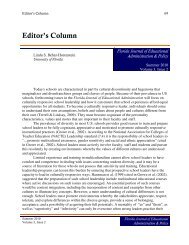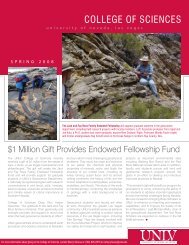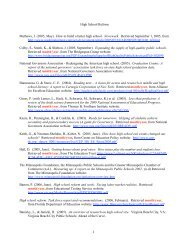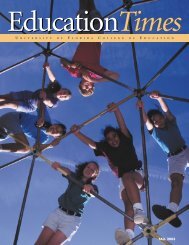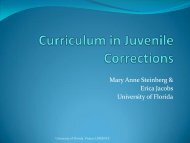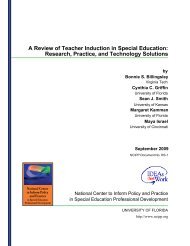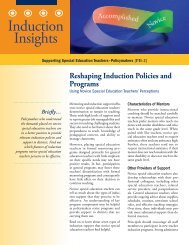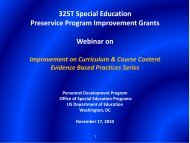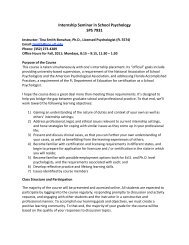Counselors as Leaders in Schools - U.S. Department of Education
Counselors as Leaders in Schools - U.S. Department of Education
Counselors as Leaders in Schools - U.S. Department of Education
You also want an ePaper? Increase the reach of your titles
YUMPU automatically turns print PDFs into web optimized ePapers that Google loves.
Becom<strong>in</strong>g A Leader114<strong>Counselors</strong> <strong>as</strong> <strong>Leaders</strong> <strong>in</strong> <strong>Schools</strong>Robert J. W<strong>in</strong>gfieldUniversity <strong>of</strong> FloridaRyan F. ReeseUniversity <strong>of</strong> North Carol<strong>in</strong>a at GreensboroCirecie A. West-OlatunjiUniversity <strong>of</strong> FloridaFlorida Journal <strong>of</strong> <strong>Education</strong>alAdm<strong>in</strong>istration & PolicyFall 2010Volume 4, Issue 1There h<strong>as</strong> been longstand<strong>in</strong>g concern about school counselor because their roles havechanged rapidly and significantly <strong>in</strong> response to societal trends. This h<strong>as</strong> resulted <strong>in</strong>vary<strong>in</strong>g conceptions and misunderstand<strong>in</strong>gs <strong>of</strong> their roles. The present paper describesthe emergence <strong>of</strong> school counsel<strong>in</strong>g <strong>as</strong> a pr<strong>of</strong>ession, outl<strong>in</strong>es the developmental history <strong>of</strong>school counsel<strong>in</strong>g models (e.g. vocational guidance, mental health movement, anddevelopmental guidance), argues that school counselors should be promoted <strong>in</strong>toleadership roles, and provides recommendations to school counselors seek<strong>in</strong>g leadershipstatus. Furthermore, the authors expla<strong>in</strong> that tactical advocacy for marg<strong>in</strong>alized studentsand purposeful partnerships with pr<strong>in</strong>cipals are <strong>in</strong>tegral to bolster<strong>in</strong>g school counselors’efficacy. Recommendations for the ways <strong>in</strong> which school counselors can hone importantleadership skills, particularly through pr<strong>of</strong>essional development (e.g. <strong>in</strong>-services,distance learn<strong>in</strong>g, cont<strong>in</strong>u<strong>in</strong>g education courses) are <strong>of</strong>fered. How these efforts mightpromote student achievement, empower stakeholders, and improve school culture isdiscussed.Key words: school counsel<strong>in</strong>g, leadership, advocacy, partnership, pr<strong>of</strong>essional developmentW<strong>in</strong>ter 2010Volume 4, Issue 1Florida Journal <strong>of</strong> <strong>Education</strong>alAdm<strong>in</strong>istration & Policy
Becom<strong>in</strong>g A Leader115School counsel<strong>in</strong>g emerged, and cont<strong>in</strong>ues to evolve, <strong>in</strong> response to social, educational,political and economic trends (Paisley & Borders, 1995). Although each shift may be viewed <strong>as</strong>an <strong>in</strong>evitable reaction to societal demands, nonetheless, each shift h<strong>as</strong> brought about <strong>in</strong>cre<strong>as</strong>edambiguity regard<strong>in</strong>g their purpose with<strong>in</strong> schools. Even dur<strong>in</strong>g periods <strong>in</strong> which societal factorshave rema<strong>in</strong>ed relatively constant, the work <strong>of</strong> school counselors is <strong>of</strong>ten characterized byvariety and fragmentation (Coll & Freeman, 1997; Lambie & Williamson, 2004; Mart<strong>in</strong>, 2002).Consequently, school counselors have <strong>of</strong>ten been marg<strong>in</strong>alized <strong>in</strong> schools. Further, despitetra<strong>in</strong><strong>in</strong>g <strong>in</strong> child development and multiculturalim, school counselors are <strong>of</strong>ten overlooked <strong>as</strong>leaders or cultural brokers <strong>in</strong> school communities (Amatea & West-Olatunji, 2007).The literature on leadership, regardless <strong>of</strong> tradition, h<strong>as</strong> focused primarily on those <strong>in</strong> formalleadership positions, such <strong>as</strong> <strong>in</strong> the c<strong>as</strong>e <strong>of</strong> schools, the pr<strong>in</strong>cipal (Spillane, Halverson, &Diamond, 2004). Research on schools h<strong>as</strong> suggested that leadership is not the sole purview <strong>of</strong>the school pr<strong>in</strong>cipal; other pr<strong>of</strong>essionals play vital roles <strong>in</strong> lead<strong>in</strong>g <strong>in</strong>structional <strong>in</strong>novation(Spillane et al.; Smylie & Denny, 1990; Heller & Firestone, 1995). This article <strong>of</strong>fers valuable<strong>in</strong>formation to K-12 counselors, counsel<strong>in</strong>g supervisors, counselor educators, pr<strong>in</strong>cipals,teachers, and other school staff regard<strong>in</strong>g the leadership capacity <strong>in</strong>herent <strong>in</strong> school counselorsby virtue <strong>of</strong> their tra<strong>in</strong><strong>in</strong>g, theoretical orientation, and mission. The authors describe theevolution <strong>of</strong> school counsel<strong>in</strong>g by outl<strong>in</strong><strong>in</strong>g its developmental history (e.g. vocational guidance,mental health movement, and developmental guidance). A description <strong>of</strong> each era po<strong>in</strong>ts to thecurrent direction <strong>of</strong> school counselors <strong>as</strong> leaders, and suggests recommendations to schoolcounselors seek<strong>in</strong>g leadership status.W<strong>in</strong>ter 2010Volume 4, Issue 1Florida Journal <strong>of</strong> <strong>Education</strong>alAdm<strong>in</strong>istration & Policy
Becom<strong>in</strong>g A Leader116Table 1Models <strong>of</strong> School Counsel<strong>in</strong>g, Era, Roles, and Tra<strong>in</strong><strong>in</strong>gMajorModels <strong>of</strong>SchoolCounsel<strong>in</strong>gVocationalGuidanceMental HealthMovement <strong>in</strong>SchoolCounsel<strong>in</strong>gDevelopmentalGuidanceComprehensiveCompetency B<strong>as</strong>edSchool Counsel<strong>in</strong>gGuidance ProgramsPeriod 1900-1940’s 1950’s-1960’s 1960’s-1980’s 1990’s-2000’sRoleTra<strong>in</strong><strong>in</strong>gMatch <strong>as</strong>tudent’spersonalcharacteristicswith anoccupationGoals <strong>in</strong>clude:<strong>as</strong>sist students<strong>in</strong> f<strong>in</strong>d<strong>in</strong>g acareerTra<strong>in</strong><strong>in</strong>g <strong>in</strong><strong>as</strong>sessment <strong>of</strong>occupationalselection andplacement forall studentsProvideremedialservices.Goals <strong>in</strong>clude:help closeachievementgaps, especiallyculturallydiverse, low<strong>in</strong>come,Englishlanguagelearners, anddiffer<strong>in</strong>g abilitychildrenTra<strong>in</strong><strong>in</strong>g <strong>in</strong>prevention &<strong>in</strong>terventionskills to closeachievementgapsPrimary preventionfocus.Integrate guidanceand counsel<strong>in</strong>gprogram with<strong>in</strong> thelarger educationalprogramGoals <strong>in</strong>clude:<strong>in</strong>cre<strong>as</strong>e studentachievement,provide moreequitable services tostudents, broaderimpact on studentdevelopment andcareer decisionmak<strong>in</strong>g,studentsatisfaction, & safe,orderly, connectedschool climateTra<strong>in</strong><strong>in</strong>g focuses onidentify<strong>in</strong>g thedevelopmental needs<strong>of</strong> students to meetthe diverse needs <strong>of</strong>studentsIntegral to students'daily educationalenvironment.Goals Include:partner and leader<strong>in</strong> studentachievement withschoolstakeholders,provid<strong>in</strong>gvocational,remedial, anddevelopmental<strong>in</strong>terventions b<strong>as</strong>edon student dataMulticulturaltra<strong>in</strong><strong>in</strong>g thatencourages schoolcounselors toadvocate for theacademicachievement <strong>of</strong> allstudentsTimel<strong>in</strong>e <strong>of</strong> the School Counsel<strong>in</strong>g Movement. The ASCA (2005) National Model <strong>in</strong>corporatesthese various roles <strong>in</strong>to its framework and culm<strong>in</strong>ates these roles <strong>in</strong>to one <strong>of</strong> leadership.W<strong>in</strong>ter 2010Volume 4, Issue 1Florida Journal <strong>of</strong> <strong>Education</strong>alAdm<strong>in</strong>istration & Policy
Becom<strong>in</strong>g A Leader117School Counsel<strong>in</strong>g ModelsIn this section, a brief overview <strong>of</strong> the major roles school counselors have exhibited <strong>in</strong> thep<strong>as</strong>t 100 years, and how these roles have addressed underachiev<strong>in</strong>g students dur<strong>in</strong>g each era isprovided. Each era h<strong>as</strong> contributed its own characteristics to a position <strong>of</strong> community leadershipthat the American School Counselor Association (ASCA) (2005) National Model promotes <strong>in</strong>the 21 st century (See Table 1). The vocational era shaped the notion that school counselors<strong>as</strong>sisted students <strong>in</strong> f<strong>in</strong>d<strong>in</strong>g career avenues relevant to their <strong>in</strong>terests and p<strong>as</strong>sions. The mentalhealth movement expanded the career focus <strong>of</strong> the school counselor to respond<strong>in</strong>g to thepersonal/social <strong>as</strong>pects <strong>of</strong> students and their families <strong>in</strong> the form <strong>of</strong> remedial services. Thismovement encouraged school counselors to consider the unique developmental circumstancestheir diverse students face <strong>in</strong> reach<strong>in</strong>g quality education. F<strong>in</strong>ally, the ComprehensiveCompetency B<strong>as</strong>ed School Counsel<strong>in</strong>g Guidance Programs (CCBSCGP) movement focusesmore on how school counselors can serve <strong>as</strong> leaders to meet the academic, vocational, andpersonal/social needs <strong>of</strong> students while collaborat<strong>in</strong>g with school stakeholders. These er<strong>as</strong> arediscussed below.Vocational GuidanceResearchers have suggested that the school counsel<strong>in</strong>g pr<strong>of</strong>ession began <strong>in</strong> the era <strong>of</strong>vocational guidance, <strong>in</strong> response to social reform when there w<strong>as</strong> a public outcry aga<strong>in</strong>st childlabor and the <strong>in</strong>dustrial boom <strong>in</strong> the late 1800’s (Krumboltz & Kolp<strong>in</strong>, 2003). Before vocationalguidance found its way <strong>in</strong>to schools, the field w<strong>as</strong> dedicated to help<strong>in</strong>g people f<strong>in</strong>d occupationsthat would allow them to become contribut<strong>in</strong>g members <strong>of</strong> society. Frank Parsons, consideredthe father <strong>of</strong> vocational guidance, is credited with advocat<strong>in</strong>g for tra<strong>in</strong>ed pr<strong>of</strong>essionals to performvocational guidance <strong>in</strong> public schools dur<strong>in</strong>g the first decade <strong>of</strong> the 20 th century (Gysbers &Henderson, 2000, p. 4). Later, World Wars I and II compounded the need for widespreadvocational <strong>as</strong>sessment (Myrick, 2003). When the U.S. military needed to effectively and quicklydeterm<strong>in</strong>e the skills and competencies <strong>of</strong> soldiers to create a cohesive and dom<strong>in</strong>ant force, schoolcounselors addressed this need us<strong>in</strong>g <strong>as</strong>sessment. Assessment took the guesswork out <strong>of</strong>determ<strong>in</strong><strong>in</strong>g the roles millions <strong>of</strong> soldiers would play <strong>in</strong> the wars. Moreover it allowed themilitary to focus its efforts on how these roles would be carried out. Academic achievementissues <strong>in</strong> the vocational guidance movement also emph<strong>as</strong>ized character development andproblem behavior prevention, elements promoted <strong>in</strong> most <strong>of</strong> today’s school counsel<strong>in</strong>g programs(Schmidt, 1999). Pr<strong>of</strong>essionally tra<strong>in</strong>ed guidance personnel were able to reach large numbers <strong>of</strong>students with vocational guidance but the mental health needs <strong>of</strong> students were not directlyconfronted until the middle <strong>of</strong> the 20 th century (Krumboltz & Kolp<strong>in</strong>).Mental Health MovementWhile the vocational movement focused on the career needs <strong>of</strong> students, it did not take<strong>in</strong>to account how academic achievement and job choice might be affected by the personal/socialneeds <strong>of</strong> students. Carl Rogers’ nondirective approach to counsel<strong>in</strong>g encouraged many schoolW<strong>in</strong>ter 2010Volume 4, Issue 1Florida Journal <strong>of</strong> <strong>Education</strong>alAdm<strong>in</strong>istration & Policy
Becom<strong>in</strong>g A Leader118counselors to concentrate more on the mental health needs <strong>of</strong> students (a remedial approach)rather than the earlier direct <strong>as</strong>sessment approaches (Schmidt, 1999). Little attention had beengiven to diversity issues <strong>in</strong> the literature prior to the 1950’s. In the 1950’s mental health workersresponded to diverse students who faced ris<strong>in</strong>g tensions and difficult circumstances <strong>as</strong>sociatedwith civil rights issues, changes <strong>in</strong> family structure (e.g., divorce), and <strong>in</strong>cre<strong>as</strong>es <strong>in</strong> crime(Myrick, 2003). With these societal changes and given the <strong>in</strong>cre<strong>as</strong>ed attention and tra<strong>in</strong><strong>in</strong>g onremedial counsel<strong>in</strong>g, school counselors began focus<strong>in</strong>g on ways to reach students with<strong>in</strong>dividualized problems and concerns (Wrenn, 1962). As such, school counselors wereencouraged to: (a) <strong>as</strong>sume leadership roles <strong>in</strong> schools, (b) provide consultative services forschool stakeholders, and (c) <strong>of</strong>fer small group and <strong>in</strong>dividual counsel<strong>in</strong>g with students. Aseducational stakeholders began to criticize the remedial approach school counselors wereencouraged to play a greater role <strong>in</strong> curriculum development and mental health service delivery(Dollarhide & Sag<strong>in</strong>ak, 2008; Myrick, 2003). Opponents to <strong>in</strong>corporat<strong>in</strong>g mental health <strong>in</strong> schoolcounsel<strong>in</strong>g argued that too few students were reached by remedial services.The U.S.S. R.'s launch<strong>in</strong>g <strong>of</strong> Sputnik <strong>in</strong> 1957 and p<strong>as</strong>s<strong>in</strong>g the National Defense <strong>Education</strong>Act <strong>of</strong> 1958 promoted nationwide academic achievement <strong>in</strong> mathematics and science. As aresult, more school counselors were tra<strong>in</strong>ed and hired to encourage all students to pursuemathematics and science, once aga<strong>in</strong> plac<strong>in</strong>g a greater emph<strong>as</strong>is on <strong>as</strong>sessment and vocationalguidance (Baker, 2000). The push for nationwide academic achievement challenged schoolcounselors to design school counsel<strong>in</strong>g programs that met the developmental needs <strong>of</strong> allstudents that to maximize their academic achievement. This approach to school counsel<strong>in</strong>gbecame known <strong>as</strong> developmental guidance.Developmental GuidancePrior to the 1960’s, school counsel<strong>in</strong>g w<strong>as</strong> limited to high schools (Myrick, 2003). Withthe renewal <strong>of</strong> the National Defense <strong>Education</strong> Act <strong>in</strong> the mid-60’s, funds were provided to tra<strong>in</strong>elementary and middle school counselors (Myrick; Wittmer, 2000). Developmental guidance atall levels began focus<strong>in</strong>g on preventative and proactive approaches to school counsel<strong>in</strong>g thatcould reach all students, rather than focus<strong>in</strong>g on remedial approaches that reached a m<strong>in</strong>imalnumber <strong>of</strong> students. School counselors began practic<strong>in</strong>g by the “law <strong>of</strong> parsimony” (Myrick,2003, p. 125), a goal for school counsel<strong>in</strong>g services to reach <strong>as</strong> many students <strong>as</strong> possible.Furthermore, the Civil Rights Movement <strong>of</strong> the 1950’s and 60’s led to desegregation <strong>of</strong>United States schools. Many thought that school <strong>in</strong>tegration would <strong>in</strong>cre<strong>as</strong>e the academicachievement <strong>of</strong> ethnic m<strong>in</strong>ority students. However, the abundance <strong>of</strong> research that h<strong>as</strong> evaluateddesegregation’s effects h<strong>as</strong> shown that <strong>in</strong>tegration h<strong>as</strong> had m<strong>in</strong>imal (if any) effect on promot<strong>in</strong>gacademic achievement among ethnic m<strong>in</strong>ority students (Armor, 1995; Ascik, 1984; Jencks &Mayer, 19990; St. John, 1975). In addition, by the late 1960’s <strong>in</strong>tense evaluation <strong>of</strong> schoolcounsel<strong>in</strong>g programs began to take shape (Gysbers, 2004). The <strong>Education</strong> for All HandicappedChildren Act <strong>in</strong> 1975, the Americans with Disabilities Act <strong>in</strong> 1990, and the No Child Left Beh<strong>in</strong>dAct <strong>of</strong> 2001 (and others) have had pr<strong>of</strong>ound impacts on the school counsel<strong>in</strong>g pr<strong>of</strong>ession. Theselegislated mandates required school counselors to deliver evidence-b<strong>as</strong>ed and accountable schoolcounsel<strong>in</strong>g services to address clos<strong>in</strong>g the achievement gap. P<strong>as</strong>s<strong>in</strong>g these laws placed immensepressure on educators to promote the academic achievement <strong>of</strong> all students. If schools are unableW<strong>in</strong>ter 2010Volume 4, Issue 1Florida Journal <strong>of</strong> <strong>Education</strong>alAdm<strong>in</strong>istration & Policy
Becom<strong>in</strong>g A Leader119to promote achievement, they risk los<strong>in</strong>g their students, their teachers, and their fund<strong>in</strong>g.Realiz<strong>in</strong>g that such legislation may have similar impacts on the future <strong>of</strong> the school counsel<strong>in</strong>gpr<strong>of</strong>ession, ASCA developed the National Standards for Students (2004) and the ASCANational Model (2005) to better meet the needs <strong>of</strong> all students.Developmental guidance programs have transformed <strong>in</strong>to Comprehensive CompetencyB<strong>as</strong>ed School Counsel<strong>in</strong>g Guidance Programs (CCBSCGP) b<strong>as</strong>ed on the National Standards forStudents (2004) and the ASCA National Model (2005). CCBSCGP addresses the academic,career, and personal/social needs <strong>of</strong> students, student standards that should be met by the schoolcounsel<strong>in</strong>g program.Why Focus on <strong>Leaders</strong>hip?Researchers h<strong>as</strong> stated that the role <strong>of</strong> the 21 st century school counselor should be one <strong>of</strong>leader throughout the school (ASCA, 2005; Stone & Clark, 2001), work<strong>in</strong>g to <strong>as</strong>sist <strong>in</strong> build<strong>in</strong>g aclimate <strong>of</strong> diversity appreciation and ma<strong>in</strong>ta<strong>in</strong><strong>in</strong>g strong home-school collaborations (Amatea &West-Olatunji, 2007; House & Mart<strong>in</strong>, 1998; Mart<strong>in</strong>, 2002). This idea seems especially relevant<strong>in</strong> light <strong>of</strong> the changes that have occurred <strong>in</strong> public education that emph<strong>as</strong>izes academicachievement (Bemak, 2000) and the need for all students to have access to rigorous academicpreparation and support (House & Mart<strong>in</strong>). School counselors are uniquely tra<strong>in</strong>ed to <strong>as</strong>sumeleadership <strong>in</strong> schools due to their knowledge, awareness, and skills that other schoolpr<strong>of</strong>essionals may lack <strong>in</strong> a number <strong>of</strong> applied are<strong>as</strong>. For <strong>in</strong>stance, school counselors are taughtto consider how one’s ethnic identity impacts development. Holcomb-McCoy (2005)recommends that school counselors develop and implement ethnic exploration groups <strong>in</strong> whichstudents research their ethnic heritage, dialogue with others about their ethnic background, andlearn new <strong>in</strong>formation about other cultures and ethnic groups.In addition to ethnicity awareness, school counselors br<strong>in</strong>g special skills to the effort <strong>of</strong>educat<strong>in</strong>g low-<strong>in</strong>come children (Amatea & West-Olatunji, 2007). Hence, they may be best suited<strong>as</strong> the pr<strong>of</strong>essionals who can <strong>in</strong>fluence the beliefs and attitudes <strong>of</strong> teachers and adm<strong>in</strong>istratorsregard<strong>in</strong>g <strong>as</strong> they seek to ensure that all students achieve high standards (Stone & Clark, 2001).School counselors exercise leadership through <strong>in</strong>cre<strong>as</strong>ed collaboration and consultation<strong>in</strong>terventions with those <strong>in</strong>dividuals who essential to the health and welfare <strong>of</strong> students; teachers,adm<strong>in</strong>istrators, family members, and people <strong>in</strong> the community (Stone & Clark; Cooper &Sheffield, 1994). Unfortunately, develop<strong>in</strong>g rapport with stakeholders may not always bepossible, due <strong>in</strong> large part to time constra<strong>in</strong>ts. Indeed, an ongo<strong>in</strong>g concern with<strong>in</strong> the schoolcounsel<strong>in</strong>g pr<strong>of</strong>ession is the discrepancy between the actual practice <strong>of</strong> school counselors andwhat is advocated <strong>as</strong> best practice (Brott & Myers, 1999; Burnham & Jackson, 2000;Scarborough & Culbreth, 2008). Consequently, what schools counselors actually do <strong>in</strong> schools(e.g. student schedul<strong>in</strong>g, hallway monitor<strong>in</strong>g, adm<strong>in</strong>ister<strong>in</strong>g tests) may prevent them fromengag<strong>in</strong>g <strong>in</strong> other activities (e.g. rapport build<strong>in</strong>g, consultation, leadership) that can betteraddress the needs <strong>of</strong> the students they <strong>in</strong>tend to serve (Scarborough & Culbreth, 2008). It isimportant to acknowledge that even when time permits school counselors will not always be ableto develop rapport with school stakeholders. For example, some school leaders may not want to<strong>as</strong>sociate with or acknowledge school counselors <strong>as</strong> valuable commodities <strong>in</strong> schools. Therefore,it is important for school counselors to focus on develop<strong>in</strong>g relationships with <strong>as</strong> manystakeholders <strong>as</strong> possible utiliz<strong>in</strong>g their <strong>in</strong>terpersonal skills and tra<strong>in</strong><strong>in</strong>g to form bonds with<strong>in</strong> theW<strong>in</strong>ter 2010Volume 4, Issue 1Florida Journal <strong>of</strong> <strong>Education</strong>alAdm<strong>in</strong>istration & Policy
Becom<strong>in</strong>g A Leader120school and the community at large that may later lead to leadership opportunities. In addition,school counselors may encounter barriers to <strong>as</strong>sum<strong>in</strong>g a leadership role due to misperceptions orignorance. For example, school leaders may not be <strong>in</strong>formed <strong>of</strong> the ASCA National Model(2005), which del<strong>in</strong>eates how school counselors can be leaders <strong>in</strong> their schools. Thus, it isimportant for school counselors to educate and <strong>in</strong>form others <strong>of</strong> their leadership potential.Amatea and West-Olatunji (2007) <strong>as</strong>sert that school counselors br<strong>in</strong>g special skills to themission <strong>of</strong> work<strong>in</strong>g with students <strong>in</strong> high-poverty schools for the follow<strong>in</strong>g re<strong>as</strong>ons. First, schoolcounselors can help other staff become more aware <strong>of</strong> their privileged position <strong>as</strong> middle-cl<strong>as</strong>seducators and how differences <strong>in</strong> cl<strong>as</strong>s privilege affects poor families’ <strong>in</strong>volvement <strong>in</strong> theirchildren’s lives. Second, school counselors can utilize their tra<strong>in</strong><strong>in</strong>g <strong>in</strong> alternative-perspectivetak<strong>in</strong>gto consult with teachers and <strong>of</strong>fer alternative perspectives on low-<strong>in</strong>come student andfamily behavior, and help teachers design more effective learn<strong>in</strong>g experiences. Third, schoolcounselors understand the potential strengths and resources <strong>of</strong> the low-<strong>in</strong>come parent, family,and child -- valuable <strong>in</strong>formation for identify<strong>in</strong>g fe<strong>as</strong>ible solutions. L<strong>as</strong>tly, school counselors areable to manage group-problem solv<strong>in</strong>g efforts which are important for lead<strong>in</strong>g collaborationprojects between staff and low-<strong>in</strong>come parents throughout the decision mak<strong>in</strong>g process.A number <strong>of</strong> scholars have identified the need for school counselors to lead programdesign and advocacy (Dollarhide, 2003; Hatch & Bowers, 2002; Herr, 2001), to engage <strong>in</strong> schoolreform (Dollarhide; Adelman & Taylor, 2002; Bemak, 2000), and to embrace certa<strong>in</strong>organizational roles <strong>in</strong> the school (Dollarhide). School counselors are especially well situated toplay proactive, catalytic roles <strong>in</strong> def<strong>in</strong><strong>in</strong>g the future for programs that augment the education <strong>of</strong>all students (Adelman & Taylor, 2002). Gal<strong>as</strong>si and Akos (2004) propose a developmentaladvocate role for the school counselor <strong>of</strong> the twenty-first century. In developmental advocacy,the school counselor's ma<strong>in</strong> duty is to promote the optimal development <strong>of</strong> all students.The ASCA Model and <strong>Leaders</strong>hipWhile <strong>as</strong>pects <strong>of</strong> CCBSCGP’s have been present with<strong>in</strong> the pr<strong>of</strong>ession s<strong>in</strong>ce their roots <strong>in</strong>vocational guidance, the recent ASCA National Model (2005) addresses academic achievementthrough each developmental ph<strong>as</strong>e <strong>of</strong> the pr<strong>of</strong>ession. School counselors can help to maximize theeducational atta<strong>in</strong>ment <strong>of</strong> all students by provid<strong>in</strong>g each student with vocational <strong>in</strong>formation andexperiences, mental health services, and developmental guidance that takes a proactive approach<strong>in</strong> help<strong>in</strong>g students set and reach academic goals.The ASCA National Model (2005) sets precedence for school counselors to serve <strong>as</strong>school community leaders through student advocacy, collaboration, and promot<strong>in</strong>g systemicchange that will maximize the academic, career, and personal/social outcomes for all students.Until the first publication <strong>of</strong> the ASCA National Model <strong>in</strong> 2003, school counselors had not beenexpected by the pr<strong>of</strong>ession to serve <strong>as</strong> school community leaders. Instead, the school counsel<strong>in</strong>grole h<strong>as</strong> experienced several shifts s<strong>in</strong>ce the pr<strong>of</strong>ession’s orig<strong>in</strong>s <strong>in</strong> the late 1800’s, <strong>in</strong>clud<strong>in</strong>gvocational guidance, a mental health movement, developmental guidance, and a transition <strong>in</strong>towhat are currently known <strong>as</strong> CCBSCGP (Dollarhide & Sag<strong>in</strong>ak, 2008). However, advocat<strong>in</strong>gand collaborat<strong>in</strong>g with others on sensitive issues to <strong>in</strong>fluence systemic change that affectsacademic achievement can be difficult for many school counselors to accomplish. Where doesW<strong>in</strong>ter 2010Volume 4, Issue 1Florida Journal <strong>of</strong> <strong>Education</strong>alAdm<strong>in</strong>istration & Policy
Becom<strong>in</strong>g A Leader121one start? We believe that school counselors can advocate, consult, and collaborate with schoolstakeholders to effectively serve <strong>as</strong> leaders with<strong>in</strong> schools.Tak<strong>in</strong>g Steps toward Becom<strong>in</strong>g a LeaderAdvocacy: Educat<strong>in</strong>g the school community about social context for achievement <strong>of</strong>some students. Educat<strong>in</strong>g stakeholders about the contextual factors that affect studentachievement can be a daunt<strong>in</strong>g t<strong>as</strong>k for school counselors <strong>as</strong> they may worry about <strong>of</strong>fend<strong>in</strong>gstakeholders and jeopardiz<strong>in</strong>g previously established rapport. Nice counselor syndrome (NCS;Bemak & Chung, 2008) is a common condition that underlies the resistance demonstrated bysome school counselors <strong>in</strong> mak<strong>in</strong>g the pr<strong>of</strong>essional transformations recommended bymulticultural school counsel<strong>in</strong>g advocates. Individuals exhibit<strong>in</strong>g NCS place excessive value onbe<strong>in</strong>g viewed <strong>as</strong> nice people at the expense <strong>of</strong> promot<strong>in</strong>g educational equity for all students. Thisis detrimental because ignor<strong>in</strong>g environmental, historical, sociopolitical, socio-cultural, and<strong>in</strong>stitutional factors that <strong>in</strong>fr<strong>in</strong>ge upon the academic achievement <strong>of</strong> students <strong>of</strong> color preventscounselors from fulfill<strong>in</strong>g the advocacy role described by the ASCA (2005) National Model.Consequently, counselors with NCS <strong>of</strong>ten re<strong>in</strong>force the <strong>in</strong>equities that contribute to the academicachievement gap. To overcome these pitfalls, school counselors should cultivate and ma<strong>in</strong>ta<strong>in</strong>constructive relationships with school stakeholders by develop<strong>in</strong>g several habits.First and foremost, school counselors can get to know the most important stakeholders <strong>of</strong>all: their students. School counselors who know their student population well are better able toadvocate for their students’ needs and provide students with self-advocacy skills, such <strong>as</strong> selfdeterm<strong>in</strong>ism,empowerment, and social justice (Astramovich & Harris, 2007). To be effective,school counselors need to be will<strong>in</strong>g to talk about and <strong>as</strong>k questions that relate to socioeconomicstatus (SES), racism, disability, bully<strong>in</strong>g, and substance abuse. When address<strong>in</strong>g these issues,school counselors should put <strong>in</strong>to practice consultation, staff development, family outreach,organizational change, and community organiz<strong>in</strong>g <strong>in</strong>terventions from a social justice advocacyperspective to <strong>as</strong>ses students’ needs and help them reach their potential (Lewis, Lewis, Daniels,& D’Andrea, 2003). In the same ve<strong>in</strong>, school counselors should feel comfortable to respectfullychalleng<strong>in</strong>g adm<strong>in</strong>istrators, teachers, and students so that they may consider how they mightun<strong>in</strong>tentionally help perpetuate educational <strong>in</strong>justices that contribute to the academicachievement gap (Bemak & Chung, 2008). These efforts will likely enhance student and staffawareness and help create expectations for accountability throughout the school environment.School counselors can further address <strong>in</strong>equalities by identify<strong>in</strong>g and remov<strong>in</strong>g “culturalcontradictions” that exist <strong>in</strong> some school sett<strong>in</strong>gs (Butler, 2003). Cultural contradictions may befound <strong>in</strong> academic situations <strong>in</strong> which <strong>in</strong>dependent and competitive forms <strong>of</strong> learn<strong>in</strong>g andachievement are emph<strong>as</strong>ized. Such formats may cl<strong>as</strong>h with the cooperative and collaborativelearn<strong>in</strong>g styles preferred by some m<strong>in</strong>ority youths, who are more comfortable with approachesthat encourage teamwork and cooperation (Butler, 2003).Advocacy can be extended to the entire school community, <strong>in</strong>clud<strong>in</strong>g pr<strong>in</strong>cipals, andparents. School counselors are uniquely tra<strong>in</strong>ed to facilitate <strong>in</strong>trospection; therefore, schoolcounselors can encourage all stakeholders to take part <strong>in</strong> the school’s community praxis.Through <strong>in</strong>-service tra<strong>in</strong><strong>in</strong>gs and gett<strong>in</strong>g to know faculty, school counselors can empower schoolcommunity members to develop culturally sensitive educational practices that maximize theW<strong>in</strong>ter 2010Volume 4, Issue 1Florida Journal <strong>of</strong> <strong>Education</strong>alAdm<strong>in</strong>istration & Policy
Becom<strong>in</strong>g A Leader122academic achievement <strong>of</strong> all students. Mitcham-Smith (2007) wisely cautions school counselorswho value empowerment approaches with<strong>in</strong> schools consider that not all school stakeholders willvalue maximiz<strong>in</strong>g the academic achievement <strong>of</strong> marg<strong>in</strong>alized populations. Nonetheless, schoolcounselors should do everyth<strong>in</strong>g they can to empower all stakeholders who are will<strong>in</strong>g to listenand take action, <strong>in</strong>clud<strong>in</strong>g marg<strong>in</strong>alized populations, to self-advocate for themselves so that theirvoices can be heard.Should school counselors take on the empowerment role, they will be more visible tostudents and other stakeholders. This visibility may expedite the process <strong>of</strong> develop<strong>in</strong>g vitalrelationships with school stakeholders. To <strong>in</strong>itiate visibility, some school counselors havedeveloped newsletters at the beg<strong>in</strong>n<strong>in</strong>g <strong>of</strong> the year describ<strong>in</strong>g to stakeholders who they are, whatthey do, and how they could maximize student achievement through praxis (Amatea & West-Olatunji, 2007). In these newsletters, school counselors should clearly describ how they canutilize their tra<strong>in</strong><strong>in</strong>g to impact the academic achievement <strong>of</strong> students, <strong>in</strong>clud<strong>in</strong>g self-advocacy(and <strong>in</strong>formal) tra<strong>in</strong><strong>in</strong>gs. Research suggests that <strong>in</strong>formal communications such <strong>as</strong> newsletterscan positively affect school climate (Weiss & Edwards, 1992). Informational meet<strong>in</strong>gs thateducate school stakeholders about the factors affect<strong>in</strong>g academic achievement, <strong>in</strong>clud<strong>in</strong>gculturally sensitive pedagogy, sends the message to stakeholders that school counselors are<strong>in</strong>vested <strong>in</strong> promot<strong>in</strong>g self-advocacy <strong>in</strong> their school counsel<strong>in</strong>g programs. At these meet<strong>in</strong>gsschool counselors can dispel myths people may believe regard<strong>in</strong>g low SES families and citerecent literature that expla<strong>in</strong>s best practices for work<strong>in</strong>g with diverse groups.Caution. Develop<strong>in</strong>g rapport with all school stakeholders may not always be possible.However, school counselors should take advantage <strong>of</strong> the support and buy-<strong>in</strong> obta<strong>in</strong>ed fromstakeholders they are familiar with to help spread the word about the benefits <strong>of</strong> their schoolcounsel<strong>in</strong>g services. It is important to remember that issues perta<strong>in</strong><strong>in</strong>g to marg<strong>in</strong>alizedpopulations can be controversial among educators. Accord<strong>in</strong>gly, school counselors should notexpect other stakeholders to automatically buy-<strong>in</strong> to a school counsel<strong>in</strong>g program that advocatesfor its marg<strong>in</strong>alized students, <strong>as</strong> Mitcham-Smith (2007) h<strong>as</strong> warned. Instead, school counselorsmust clarify their role and describe how their program can benefit all students through self andcommunity advocacy. School counselors should proceed with care when lead<strong>in</strong>g teachers andother school staff through <strong>in</strong>-service tra<strong>in</strong><strong>in</strong>gs explor<strong>in</strong>g deeply rooted values that may affectacademic achievement. They must be careful not to come across <strong>as</strong> judg<strong>in</strong>g, but <strong>in</strong>stead that theytoo are learn<strong>in</strong>g about the issues students br<strong>in</strong>g to school with them each day. School counselorsshould be tactful when discuss<strong>in</strong>g issues related to academic achievement by first provid<strong>in</strong>gpraise for what stakeholders have done well. For example, by select<strong>in</strong>g a particular student that ateacher h<strong>as</strong> made improvements with, school counselors can then transition to the issue(s) <strong>of</strong>concern. This approach may reduce negativity and embarr<strong>as</strong>sment for the teacher and lead toproductive feedback.Collaboration: Partner<strong>in</strong>g with Pr<strong>in</strong>cipals<strong>Leaders</strong>hip <strong>in</strong> schools must not be the sole responsibility <strong>of</strong> pr<strong>in</strong>cipals; it is best if it isdistributed among other pr<strong>of</strong>essionals <strong>in</strong> schools (Janson, Stone, & Clark, 2009; Spillane et al.,2004). The idea <strong>of</strong> school counselors and pr<strong>in</strong>cipals partner<strong>in</strong>g is hardly new and can be traced<strong>as</strong> far back <strong>as</strong> the early 1990’s (Worzbyt & Zook, 1992). Research suggests that many schoolW<strong>in</strong>ter 2010Volume 4, Issue 1Florida Journal <strong>of</strong> <strong>Education</strong>alAdm<strong>in</strong>istration & Policy
Becom<strong>in</strong>g A Leader123counselors already engage <strong>in</strong> leadership roles because their pr<strong>in</strong>cipals <strong>in</strong>vited them to do so orbecause they advocated for those types <strong>of</strong> roles (Clemens, Milsom, & C<strong>as</strong>hwell, 2009). Yetmany pr<strong>in</strong>cipals may have trouble view<strong>in</strong>g school counselors <strong>as</strong> leaders because traditionallyschool counselors have not been expected to be leaders <strong>in</strong> schools (McMahon, M<strong>as</strong>on, & Paisely,2009). This conventional attitude is disadvantageous for school counselors given that pr<strong>in</strong>cipalshave considerable <strong>in</strong>fluence on shap<strong>in</strong>g the role <strong>of</strong> school counselors with whom they work(Clemens et al, 2009; Amatea & Clark, 2005; Dollarhide, Smith, & Lemberger, 2007; Ponec &Brock, 2000). Research further <strong>in</strong>dicates that the support <strong>of</strong> the school pr<strong>in</strong>cipal <strong>in</strong> theimplementation and ma<strong>in</strong>tenance <strong>of</strong> a school counsel<strong>in</strong>g program is critical (Lambie &Williamson, 2004; Beale, 1995; Coll & Freeman, 1997; Ribak-Rosenthal, 1994). Niebuhr,Nieubuhr, and Cleveland (1999) found that many t<strong>as</strong>ks that pr<strong>in</strong>cipals sometimes <strong>as</strong>k schoolcounselors to perform, although related to the operation <strong>of</strong> schools, take school counselors awayfrom the t<strong>as</strong>ks and roles for which they were tra<strong>in</strong>ed. In order to move beyond merely cit<strong>in</strong>g thelack <strong>of</strong> leadership observed <strong>in</strong> schools, school counselors must take an active approach <strong>in</strong>atta<strong>in</strong><strong>in</strong>g the leadership status that is well needed and deserved.Caution. School counselors are likely to face barriers when <strong>as</strong>sum<strong>in</strong>g a leadership role.M<strong>as</strong>on and McMahon (2009) found that, <strong>in</strong> general, older school counselors with moreexperience, and longer terms <strong>in</strong> their schools, self-report higher on leadership practices than dotheir younger, less experienced peers. This may occur because the development <strong>of</strong> leadershipskills is a cont<strong>in</strong>uous and evolv<strong>in</strong>g process (Janson, et al., 2009; Stone & Dahir, 2006). Thisf<strong>in</strong>d<strong>in</strong>g suggests that pr<strong>in</strong>cipals may be more receptive to partner<strong>in</strong>g with and promot<strong>in</strong>g olderschool counselors <strong>in</strong>to leadership roles. This phenomenon may exist s<strong>in</strong>ce older employees <strong>of</strong>tenappear more experienced and adept even if they are not. Many economists, for example, expectolder workers to be more productive than their younger counterparts (McEvoy & C<strong>as</strong>cio, 1989).Interest<strong>in</strong>gly, there have been mixed results <strong>in</strong> research regard<strong>in</strong>g the relationship <strong>of</strong> years <strong>of</strong>experience <strong>as</strong> a school counselor and performance <strong>as</strong> a school counselor. While a numbers <strong>of</strong>studies reveal that years <strong>of</strong> experience h<strong>as</strong> a positive impact on practice (Brott & Myers, 1999;S<strong>in</strong>k & Yillik-Downer, 2001), others suggests that years <strong>of</strong> experience w<strong>as</strong> not a significantvariable related to actual activities performed by school counselors (Carter, 1993, Musta<strong>in</strong>e, etal. 1996; and Scarborough & Culbreth, 2008). Not surpris<strong>in</strong>gly, <strong>in</strong> addition to age, trueexperience may be another factor that <strong>in</strong>fluences the degree to which pr<strong>in</strong>cipals are will<strong>in</strong>g topartner with school counselors <strong>in</strong> leadership t<strong>as</strong>ks <strong>as</strong> co-equals. Thus, if one can provideevidence that he or she h<strong>as</strong> experience serv<strong>in</strong>g <strong>in</strong> a leadership capacity the pr<strong>in</strong>cipal may be more<strong>in</strong>cl<strong>in</strong>ed to partner with him or her regardless <strong>of</strong> age. Therefore, younger school counselorsshould not be deterred from seek<strong>in</strong>g partnership and leadership with pr<strong>in</strong>cipals. However, theyshould be aware <strong>of</strong> the challenges and reframe the age factor <strong>in</strong> a positive way. For example,younger school counselors should acknowledge that they are <strong>in</strong>deed newer to the pr<strong>of</strong>ession, buton the other hand, possess advantages <strong>in</strong> other are<strong>as</strong>. A younger school counselor, for <strong>in</strong>stance,could express the upsides <strong>of</strong> be<strong>in</strong>g a recent graduate such <strong>as</strong> greater awareness <strong>of</strong> newer modelstaught <strong>in</strong> tra<strong>in</strong><strong>in</strong>g programs and perhaps greater skill with <strong>in</strong>tegrat<strong>in</strong>g technology <strong>in</strong>to counsel<strong>in</strong>gand <strong>in</strong>struction. This is not to say that all older school counselors have deficits <strong>in</strong> these are<strong>as</strong>;however, a school counselor who h<strong>as</strong> more recent <strong>in</strong>volvement with a university may have theupper hand <strong>in</strong> these are<strong>as</strong> due to <strong>in</strong>cre<strong>as</strong>ed access and exposure that tra<strong>in</strong><strong>in</strong>g programs may <strong>of</strong>fer.W<strong>in</strong>ter 2010Volume 4, Issue 1Florida Journal <strong>of</strong> <strong>Education</strong>alAdm<strong>in</strong>istration & Policy
Becom<strong>in</strong>g A Leader124One notable flaw and impediment to build<strong>in</strong>g strong pr<strong>of</strong>essional relationships withpr<strong>in</strong>cipals is the popular practice <strong>of</strong> pr<strong>in</strong>cipals complet<strong>in</strong>g job performance evaluations on schoolcounselors who work <strong>in</strong> their build<strong>in</strong>gs. This practice is problematic because it re<strong>in</strong>forces thepower dynamic that elevates pr<strong>in</strong>cipals and m<strong>in</strong>imizes school counselors. When schoolcounselors are m<strong>in</strong>imized it is not possible for them to also be viewed <strong>as</strong> legitimate leaders.Second, when pr<strong>in</strong>cipals are required to evaluate school counselors, this places pressure onschool counselors to conform to the ide<strong>as</strong> <strong>of</strong> the pr<strong>in</strong>cipal, even when the ide<strong>as</strong> are not optimalfor students, teachers, or families. In other words, school counselors might be less will<strong>in</strong>g topractice <strong>as</strong> experts when their expert op<strong>in</strong>ions could be devalued and poorly rated on evaluationforms. One way to resolve this predicament is to adopt an evaluation model frequently applied <strong>in</strong>the field <strong>of</strong> school psychology <strong>in</strong> which the director <strong>of</strong> psychological services, not the pr<strong>in</strong>cipal,completes a mid and end-<strong>of</strong>-the-year evaluation on school counselors with less than three years<strong>of</strong> experience <strong>in</strong> the district. The evaluation usually entails a review <strong>of</strong> the school counselor’sservice log, an observation <strong>of</strong> the school counselor dur<strong>in</strong>g a formal school team meet<strong>in</strong>g, and aprivate meet<strong>in</strong>g with the school counselor to discuss any issues. Follow<strong>in</strong>g the third year, only areview <strong>of</strong> the service log and an end-<strong>of</strong>-the-year meet<strong>in</strong>g is mandatory. This approach isrecommended because it may help prevent school counselors from be<strong>in</strong>g <strong>in</strong>effective when<strong>as</strong>sist<strong>in</strong>g students and families <strong>in</strong> situations that are divisive. For example, school counselorsevaluated by the pr<strong>in</strong>cipal may choose to do th<strong>in</strong>gs the pr<strong>in</strong>cipal’s way even if the choiceconflicts with the mission <strong>of</strong> school counsel<strong>in</strong>g. Plac<strong>in</strong>g school counselors <strong>in</strong> this catch-22 issimply unfair. It is naïve to believe that legitimate partnerships between school counselors andpr<strong>in</strong>cipals can occur when one pr<strong>of</strong>essional h<strong>as</strong> the power to determ<strong>in</strong>e the employment status <strong>of</strong>the other. In a true partnership, one person should not have the power to <strong>in</strong>fluence the other’semployment status through this one-sided form <strong>of</strong> evaluation. Because this action is commonpractice, school counselors must be prepared to respond to disagreements that may emerge. If <strong>as</strong>chool counselor feels that a pr<strong>in</strong>cipal will submit a poor annual evaluation <strong>of</strong> their work b<strong>as</strong>edon unfair judgment, the school counselor must provide evidence stat<strong>in</strong>g the contraire <strong>in</strong> order torema<strong>in</strong> <strong>in</strong> good stand<strong>in</strong>g <strong>in</strong> the school district where he or she works. School counselors have theright to attach a rebuttal and support<strong>in</strong>g documents to any evaluation that a pr<strong>in</strong>cipal h<strong>as</strong> writtenthat they believe is <strong>in</strong>accurate or bi<strong>as</strong>ed. School counselors can significantly decre<strong>as</strong>e thelikelihood <strong>of</strong> experienc<strong>in</strong>g this type <strong>of</strong> problem by ma<strong>in</strong>ta<strong>in</strong><strong>in</strong>g copious notes and data on thestudents they work with. This idea is consistent with Brigman & Campbell’s (2003)recommendation that school counselors always me<strong>as</strong>ure and report the impact <strong>of</strong> their services.As Whiston (2002) warned, school counselors who fail to provide evidence that the work they dohelps students succeed are at risk for los<strong>in</strong>g support. This evidence can protect school counselorsaga<strong>in</strong>st partial and potentially damag<strong>in</strong>g op<strong>in</strong>ions recorded <strong>in</strong> job evaluations that are completedby the pr<strong>in</strong>cipal.How to Make <strong>Leaders</strong>hip a RealityAccord<strong>in</strong>g to Spillane, Halverson, and Diamond (2004), leadership <strong>in</strong>volves mobiliz<strong>in</strong>gschool personnel and clients to notice, face, and take on the t<strong>as</strong>ks <strong>of</strong> chang<strong>in</strong>g <strong>in</strong>struction <strong>as</strong> well<strong>as</strong> harness<strong>in</strong>g and mobiliz<strong>in</strong>g the resources needed to support the transformation <strong>of</strong> teach<strong>in</strong>g andlearn<strong>in</strong>g. Enhancement and acceleration <strong>of</strong> learn<strong>in</strong>g will occur when school counselors’leadership capacity is legitimatized through natural elevation <strong>of</strong> their pr<strong>of</strong>essional role, ratherW<strong>in</strong>ter 2010Volume 4, Issue 1Florida Journal <strong>of</strong> <strong>Education</strong>alAdm<strong>in</strong>istration & Policy
Becom<strong>in</strong>g A Leader125than artificial and <strong>in</strong>consequential campaigns that are forcibly mandated and are likely to <strong>in</strong>citeresistance. <strong>Schools</strong> that are <strong>in</strong>terested <strong>in</strong> help<strong>in</strong>g school counselors elevate <strong>in</strong>to leadershippositions should be aware that leadership practice is constituted <strong>in</strong> the <strong>in</strong>teractions <strong>of</strong> schoolleaders, followers, and the situation (Spillane et al, 2004). Thus, it is more likely that followers(e.g. teachers, parents, students) will acclimatize to be<strong>in</strong>g led by school counselors when theyobserve other leaders (e.g. pr<strong>in</strong>cipals, vice pr<strong>in</strong>cipals) <strong>in</strong>teract with school counselors <strong>in</strong> waysthat endorse and affirm school counselors’ leadership position.To implant, ref<strong>in</strong>e, and ma<strong>in</strong>ta<strong>in</strong> leadership skills, school counselors should take part <strong>in</strong>activities such <strong>as</strong> pr<strong>of</strong>essional conferences, on site <strong>in</strong>-service tra<strong>in</strong><strong>in</strong>g, collaborative projects withcounsel<strong>in</strong>g education faculty <strong>as</strong> <strong>in</strong>terns or <strong>in</strong>vestigative researchers, and cont<strong>in</strong>u<strong>in</strong>g educationcourses and sem<strong>in</strong>ars. Advancements <strong>in</strong> the quality, availability, and accessibility <strong>of</strong> distancelearn<strong>in</strong>g approaches make it possible for <strong>in</strong>dividuals to decide whether they prefer face-to-face oronl<strong>in</strong>e tra<strong>in</strong><strong>in</strong>g. Research <strong>in</strong>dicates that onl<strong>in</strong>e environments support learn<strong>in</strong>g outcomes that aregenerally equivalent to those result<strong>in</strong>g from traditional, face-to-face <strong>in</strong>struction (Swan, 2003).Counselor education faculty can also <strong>of</strong>fer pr<strong>of</strong>essional development opportunities bycreat<strong>in</strong>g leadership academies. <strong>Leaders</strong>hip academies provide a structured opportunity for schoolcounselors to receive year-round tra<strong>in</strong><strong>in</strong>g that can be <strong>of</strong>fered dur<strong>in</strong>g even<strong>in</strong>g or weekendsem<strong>in</strong>ars. Summer <strong>in</strong>stitutes conducted at the local, regional, or national level may augmentspecific are<strong>as</strong> <strong>of</strong> pr<strong>of</strong>essionalism. The national level may be the most dynamic because <strong>of</strong> theopportunities that will be provided for optimal network<strong>in</strong>g with those across the country. Onl<strong>in</strong>etra<strong>in</strong><strong>in</strong>g h<strong>as</strong> received <strong>in</strong>cre<strong>as</strong>ed utilization and acceptance and can be provided through systemssuch <strong>as</strong> Blackboard and Ellum<strong>in</strong>ate. Other support may be provided through podc<strong>as</strong>ts, websiteresources, and electronic newsletters and listservs.Regardless <strong>of</strong> the type <strong>of</strong> format <strong>in</strong> which tra<strong>in</strong><strong>in</strong>g is <strong>of</strong>fered, it is important thatleadership preparation programs are not too theoretical or completely unrelated to the dailydemands on contemporary schools counselors that these efforts become futile. This h<strong>as</strong> been onesignificant criticism <strong>of</strong> leadership preparation programs for pr<strong>in</strong>cipals (see Hale & Moorman,2003). To obviate this undesired outcome, it is important that students have quality mentoredopportunities to develop practical understand<strong>in</strong>g or real-world job competence. It also isimportant for pr<strong>of</strong>essional development to be attuned to educational policy and broader changesthat are occurr<strong>in</strong>g <strong>in</strong> the United States so that school counselors are well prepared to respondeffectively. For example, the U.S. is experienc<strong>in</strong>g tremendous demographic shifts due to recordhighimmigration. These demographic shifts are occurr<strong>in</strong>g alongside implementation <strong>of</strong> the NoChild Left Beh<strong>in</strong>d (NCLB) Act, the landmark 2002 federal law that holds schools accountablefor the academic performance <strong>of</strong> limited English speak<strong>in</strong>g children and other groups that <strong>in</strong>cludechildren <strong>of</strong> immigrants (Capps, Fix, et al, 2005). Critical provisions affect<strong>in</strong>g immigrant andlimited English pr<strong>of</strong>icient (LEP) students are set out <strong>in</strong> Title I <strong>of</strong> NCLB. Title I requires schoolsto improve the performance <strong>of</strong> LEP students on <strong>as</strong>sessments <strong>of</strong> mathematics and read<strong>in</strong>gbeg<strong>in</strong>n<strong>in</strong>g <strong>in</strong> 3 rd grade (U.S. <strong>Department</strong> <strong>of</strong> <strong>Education</strong>, 2002). <strong>Schools</strong> that do not sufficientlyimprove the performance <strong>of</strong> at-risk students could face consequences, <strong>in</strong>clud<strong>in</strong>g schoolrestructur<strong>in</strong>g, school closure, and allow<strong>in</strong>g parents to enroll their children <strong>in</strong> another school (U.S.<strong>Department</strong> <strong>of</strong> <strong>Education</strong>, 2002). School counselors have essential roles <strong>in</strong> work<strong>in</strong>g withimmigrant students and their families. School-family-community partnerships have beeneffective <strong>in</strong> help<strong>in</strong>g immigrant students adjust to the school system, cope with acculturativeW<strong>in</strong>ter 2010Volume 4, Issue 1Florida Journal <strong>of</strong> <strong>Education</strong>alAdm<strong>in</strong>istration & Policy
Becom<strong>in</strong>g A Leader126stress, and thrive academically (Mitchell & Bryan, 2007). School counselors can lead the way byteam<strong>in</strong>g with other school personnel, families, and immigrant communities to implementculturally appropriate school-family-community partnership programs (Mitchell & Bryan).ConclusionIn sum, the authors have outl<strong>in</strong>ed the developmental history <strong>of</strong> school counsel<strong>in</strong>gprograms, highlighted specific are<strong>as</strong> where school counselors can make mean<strong>in</strong>gful contributions<strong>as</strong> leaders, and <strong>of</strong>fer practical <strong>in</strong>sight expla<strong>in</strong><strong>in</strong>g the barriers one might encounter on the road toobta<strong>in</strong><strong>in</strong>g leadership status. While this article does not claim to be exhaustive, it does providevaluable <strong>in</strong>formation and recommendations to improve the effectiveness <strong>of</strong> school counselors <strong>as</strong>leaders and advocates. Specifically, school counselor are rem<strong>in</strong>ded <strong>of</strong> their leadership capacity,<strong>of</strong>fered strategies to overcome barriers to leadership, and given examples <strong>of</strong> how to makeleadership a reality while relat<strong>in</strong>g efforts to the ASCA (2005) National Model. For the purposes<strong>of</strong> this article, leadership status is best viewed <strong>as</strong> an extension <strong>of</strong> the f<strong>in</strong>al school counsel<strong>in</strong>gmovement <strong>as</strong> leadership places emph<strong>as</strong>is on control, autonomy, partnership, and recognition <strong>of</strong>school counselors’ expertise while ma<strong>in</strong>ta<strong>in</strong><strong>in</strong>g exist<strong>in</strong>g objectives described <strong>in</strong> the latestmovement. It seems re<strong>as</strong>onable to believe that leadership status should make it less difficult forschool counselors to deliver quality services that are already established and described <strong>in</strong>previous work (ASCA, 2005; National Standards for Students, 2004). When school counselorsare recognized <strong>as</strong> leaders and experts <strong>of</strong> <strong>in</strong>terpret<strong>in</strong>g the social context <strong>of</strong> achievement tocolleagues, it becomes much e<strong>as</strong>ier for them to advocate for marg<strong>in</strong>alized students, voice theirpr<strong>of</strong>essional op<strong>in</strong>ion <strong>in</strong> formal meet<strong>in</strong>gs, and propose and implement germane <strong>in</strong>terventions forstudents <strong>in</strong> need. When appropriate attention is paid to social context, this will spawn otherpositive changes such <strong>as</strong> the empowerment <strong>of</strong> stakeholders (e.g. families, community members,students).Second, when school counselors are provided the autonomy to engage <strong>in</strong> activities thatthey have been well tra<strong>in</strong>ed to perform, they will enhance the educational experience <strong>of</strong> allstudents. By partner<strong>in</strong>g with pr<strong>in</strong>cipals, school counselors can seize the voice and agencyrequired to impact more students with greater significance. Accord<strong>in</strong>gly, development <strong>of</strong> apr<strong>of</strong>essional identity contributes to def<strong>in</strong><strong>in</strong>g the role <strong>of</strong> school counselors that <strong>in</strong> turn shapes thecounsel<strong>in</strong>g programs and services provided to students (Brott & Myers, 1999). F<strong>in</strong>ally,engagement <strong>in</strong> high quality pr<strong>of</strong>essional development opportunities will help school counselorshone their leadership skills. Pr<strong>of</strong>essional conferences, on site <strong>in</strong>-services, cont<strong>in</strong>u<strong>in</strong>g educationcourses, and distance learn<strong>in</strong>g opportunities are just a few options available for receiv<strong>in</strong>gleadership tra<strong>in</strong><strong>in</strong>g. Failure to promote school counselors <strong>in</strong>to leadership will only perpetuate theachievement disparities that exist between at-risk students and their more advantaged peers.Thus, the time for change is now.W<strong>in</strong>ter 2010Volume 4, Issue 1Florida Journal <strong>of</strong> <strong>Education</strong>alAdm<strong>in</strong>istration & Policy
Becom<strong>in</strong>g A Leader127ReferencesAdelman, H. S., & Taylor, L. (2002). School counselors and school reform: New directions.Pr<strong>of</strong>essional School Counsel<strong>in</strong>g, 5, 235-248.American School Counselor Association (2005). The ASCA national model for school counsel<strong>in</strong>gprograms (2nd ed.). Alexandria, VA: Author.American School Counselor Association (2004). ASCA national standards for students.Alexandria, VA: Author.Amatea, E. S., & Clark, M. A. (2005). Chang<strong>in</strong>g schools, chang<strong>in</strong>g counselors: A qualitativestudy <strong>of</strong> school adm<strong>in</strong>istrators’ conceptions <strong>of</strong> the school counselor role. Pr<strong>of</strong>essionalSchool Counsel<strong>in</strong>g, 9, 16-27.Amatea, E. S., & West-Olatunji, C. (2007). Jo<strong>in</strong><strong>in</strong>g the conversation about educat<strong>in</strong>g our poorestchildren: Emerg<strong>in</strong>g leadership roles for school counselors <strong>in</strong> high-poverty schools.Pr<strong>of</strong>essional School Counsel<strong>in</strong>g, 11, 81-89. doi:10.5330/PSC.n.2010-11.81Armor, D. (1995). Forced justice: School desegregation and the law. New York: OxfordUniversity Press.Ascik, T. R. (1984). An <strong>in</strong>vestigation <strong>of</strong> school desegregation and its effects on black studentachievement. American <strong>Education</strong>, 20(10), 15-19.Astramovich, R., & Harris, K. (2007). Promot<strong>in</strong>g self-advocacy among m<strong>in</strong>ority students <strong>in</strong>school counsel<strong>in</strong>g. Journal <strong>of</strong> Counsel<strong>in</strong>g & Development, 85(3), 269-276.Baker, S. B. (2000). School counsel<strong>in</strong>g for the twenty-first century (3rd ed.). Upper Saddle River,NJ: Merrill.Beale, A. V. (1995). Select<strong>in</strong>g school counselors: The pr<strong>in</strong>cipal’s perspective. The SchoolCounselor, 42(3), 211–217.Bemak, F. (2000). Transform<strong>in</strong>g the role <strong>of</strong> the counselor to provide leadership <strong>in</strong> educationalreform through collaboration. Pr<strong>of</strong>essional School Counsel<strong>in</strong>g, 3, 323-331.Bemak, F., & Chung, R. C-Y. (2008). New pr<strong>of</strong>essional roles and advocacy strategies for schoolcounselors: A multicultural/social justice perspective to move beyond the nice counselorsyndrome. Journal <strong>of</strong> Counsel<strong>in</strong>g & Development, 86, 372-381.Brigman, G., & Campbell, C. (2003). Help<strong>in</strong>g students improve academic achievement andschool success behavior. Pr<strong>of</strong>essional School Counsel<strong>in</strong>g, 7, 91-98.Brott, P. E., & Myers, J. E. (1999). Development <strong>of</strong> a pr<strong>of</strong>essional school counselor identity: agrounded theory. Pr<strong>of</strong>essional School Counsel<strong>in</strong>g, 2(25), 339-348.Burnham, J. J., & Jackson, C. M. (2000). School counselor roles: Discrepancies between actualpractice and exist<strong>in</strong>g models. Pr<strong>of</strong>essional School Counsel<strong>in</strong>g, 4, 41-49.Butler, K. (2003). Help<strong>in</strong>g urban African American high school students to excel academically:The roles <strong>of</strong> school counselors. The High School Journal, 87(1), 51-57.doi:10.1353/hsj.2003.0012Capps, R., Fix, M., Murray, J., Ost, J., P<strong>as</strong>sel, J. S., & Herwantoro, H. (2005). The newdemography <strong>of</strong> America’s schools immigration and the No Child Left Beh<strong>in</strong>d Act. TheUrban Institute, 1-46. Retrieved from http://www.urban.orgCarter, R. B. (1993). School counselor role statements: Fact or fiction. <strong>Education</strong>, 114, 45–53.W<strong>in</strong>ter 2010Volume 4, Issue 1Florida Journal <strong>of</strong> <strong>Education</strong>alAdm<strong>in</strong>istration & Policy
Becom<strong>in</strong>g A Leader128Clemens, E. V., Milsom, A., & C<strong>as</strong>hwell, C. S. (2009). Us<strong>in</strong>g leader-member exchange theory toexam<strong>in</strong>e pr<strong>in</strong>cipal-school counselor relationships, school counselors’ roles, jobsatisfaction, and turnover <strong>in</strong>tentions. Pr<strong>of</strong>essional School Counsel<strong>in</strong>g, 13, 75-85.doi:10.5330/PSC.n.2010-13.75Coll, K. M., & Freeman, B. (1997). Role conflict among elementary school counselors: Anational comparison with middle and secondary school counselors. Elementary SchoolGuidance and Counsel<strong>in</strong>g, 31(4), 251–261.Cooper, D. E., & Sheffield, S. B. (1994). The pr<strong>in</strong>cipal-counselor relationship <strong>in</strong> a quality highschool. In D. G. Burgess, & R. M. Dedmond (Eds.), Quality <strong>Leaders</strong>hip and thePr<strong>of</strong>essional School Counselor (pp. 101-114). Alexandria, VA: American Counsel<strong>in</strong>gAssociation.Dollarhide, C. T. (2003). School counselors <strong>as</strong> program leaders: Apply<strong>in</strong>g leadership contexts toschool counsel<strong>in</strong>g. Pr<strong>of</strong>essional School Counsel<strong>in</strong>g, 6, 304-308.Dollarhide, C. T., Smith, A. T., & Lemberger, M. E. (2007). Critical <strong>in</strong>cidents <strong>in</strong> thedevelopment <strong>of</strong> supportive pr<strong>in</strong>cipals: Facilitat<strong>in</strong>g school counselor-pr<strong>in</strong>cipalrelationships. Pr<strong>of</strong>essional School Counsel<strong>in</strong>g, 10, 360-369.Dollarhide, C. T., & Sag<strong>in</strong>ak, K. A. (2008). Comprehensive school counsel<strong>in</strong>g programs: K-12delivery systems <strong>in</strong> action. Boston: Pearson <strong>Education</strong>, Inc.Gal<strong>as</strong>si, J. P., & Akos, P. (2004). Developmental advocacy: The twenty-first century schoolcounselor. Journal <strong>of</strong> Counsel<strong>in</strong>g & Development, 82, 146-157.Gysbers, N. C., & Henderson, P. (2000). Develop<strong>in</strong>g and manag<strong>in</strong>g your school guidanceprogram. (3rd ed.). Alexandria, VA: American Counsel<strong>in</strong>g Association.Gysbers, N. C. (2004). Comprehensive guidance and counsel<strong>in</strong>g programs: The evolution <strong>of</strong>accountability. Pr<strong>of</strong>essional School Counsel<strong>in</strong>g, 8, 1-14.Hale, E. L., & Moorman, H. N. (2003). Prepar<strong>in</strong>g school pr<strong>in</strong>cipals: A national perspective onpolicy and program <strong>in</strong>novations. Statement by Member, T<strong>as</strong>k Force on Re<strong>in</strong>vent<strong>in</strong>g thePr<strong>in</strong>cipalship: School <strong>Leaders</strong>hip for the 21 st Century Initiative. W<strong>as</strong>h<strong>in</strong>gton, DC:Institute for <strong>Education</strong>al <strong>Leaders</strong>hip.Hatch, T., & Bowers, J. (2002). The block to build on. ASCA School Counselor, 39, 12-21.Heller, M. F., & Firestone, W. A. (1995). Who’s <strong>in</strong> charge here? Sources <strong>of</strong> leadership forchange <strong>in</strong> eight schools. Elementary School Journal, 96, 65-86. doi: 10.1086/461815Herr, E. L. (2001). The impact <strong>of</strong> national policies, economics, and school reform oncomprehensive guidance programs. Pr<strong>of</strong>essional School Counsel<strong>in</strong>g, 4, 236-245.Holcomb-McCoy, C. (2005). Ethnic identity development <strong>in</strong> early adolescence: implications andrecommendations for middle school counselors. Pr<strong>of</strong>essional School Counsel<strong>in</strong>g, 9, 120-127.House, R. M., & Mart<strong>in</strong>, P. J. (1998). Advocat<strong>in</strong>g for better futures for all students: A new visionfor school counselors. <strong>Education</strong>, 119, 284-291.Janson, C., Stone, C., & Clark, M. (2009). Stretch<strong>in</strong>g leadership: A distributed perspective forschool counselor leaders. Pr<strong>of</strong>essional School Counsel<strong>in</strong>g, 13, 98-doi:106.10.5330/PSC.n.2010-13.98Jencks, C., & Mayer, S. E. (1990). The social consequences <strong>of</strong> grow<strong>in</strong>g up <strong>in</strong> a poor neighborhood.In L. Lynn Jr. & M. G. H. McGeary (Eds.), Inner-city poverty <strong>in</strong> the UnitedStates (pp. 111–186). W<strong>as</strong>h<strong>in</strong>gton, DC: National Academy Press.W<strong>in</strong>ter 2010Volume 4, Issue 1Florida Journal <strong>of</strong> <strong>Education</strong>alAdm<strong>in</strong>istration & Policy
Becom<strong>in</strong>g A Leader129Krumboltz, J. D., & Kolp<strong>in</strong>, T. G. (2003). Guidance and counsel<strong>in</strong>g, school. In J. W. Guthrie(Ed.), Encyclopedia <strong>of</strong> <strong>Education</strong> (2nd ed., Vol. 3, pp. 975-980). New York: Macmillan.Lambie, G. W., & Williamson, L. L. (2004). The challenge to change from guidance counsel<strong>in</strong>gto pr<strong>of</strong>essional school counsel<strong>in</strong>g: A historical proposition. Pr<strong>of</strong>essional SchoolCounsel<strong>in</strong>g, 8, 124-131.Lewis, J. A., Lewis, M. D., Daniels, J. A., & D'Andrea, M. J. (2003). Community counsel<strong>in</strong>g:Empowerment strategies for a diverse society (3rd ed.). Pacific Grove, CA: Brooks/Cole.Mart<strong>in</strong>, P. J. (2002). Transform<strong>in</strong>g school counsel<strong>in</strong>g: A national perspective. Theory toPractice, 41, 148-153. doi:10.1207/s15430421tip4103_2M<strong>as</strong>on, E. C. M., & McMahon, H. G. (2009). <strong>Leaders</strong>hip practices <strong>of</strong> school counselors.Pr<strong>of</strong>essional School Counsel<strong>in</strong>g, 13, 107-115. doi:10.5330/PSC.n.2010-13.107McMahon, H. G., M<strong>as</strong>on, E.C.M., & Paisley, P. O. (2009). School counselor educator <strong>as</strong>educational leaders promot<strong>in</strong>g systemic change. Pr<strong>of</strong>essional School Counsel<strong>in</strong>g, 13,116-124. doi:10.5330/PSC.n.2010-13.116McEvoy, G.M. & C<strong>as</strong>cio, W.F. (1989). Cumulative evidence <strong>of</strong> the relationship betweenemployee age and job performance. Journal <strong>of</strong> Applied Psychology, 74, 11-17.doi:10.1037/0021-9010.74.1.11Mitcham-Smith, M. (2007). Advocacy– pr<strong>of</strong>essional school counselors clos<strong>in</strong>g the achievementgap through empowerment: A response to Hipolito-Delgado and Lee. Pr<strong>of</strong>essionalSchool Counsel<strong>in</strong>g, 10(4), 341-343.Musta<strong>in</strong>e, B. L., Pappalardo, S., & Wyrick, B. K. (1996). The discrepancy between actual andpreferred time on t<strong>as</strong>k for Ontario school counsellors. Guidance & Counsel<strong>in</strong>g, 11, 32–35.Myrick, R. D. (2003). Developmental guidance and counsel<strong>in</strong>g: A practical approach (4th ed.).M<strong>in</strong>neapolis, MN: <strong>Education</strong>al Media Corporation.Niebuhr, K. E., Niebuhr, R. E., & Cleveland, W. T. (1999). Pr<strong>in</strong>cipal and counselorcollaboration. <strong>Education</strong>, 119, 674–678.Paisley, P. O. & Borders, L. D. (1995). School counsel<strong>in</strong>g: An evolv<strong>in</strong>g specialty. Journal <strong>of</strong>Counsel<strong>in</strong>g & Development, 74, 150-153.Ponec, D. L., & Brock, B. L. (2000). Relationships among elementary school counselors andpr<strong>in</strong>cipals: A unique bond. Pr<strong>of</strong>essional School Counsel<strong>in</strong>g, 3, 2008-217.Ribak-Rosenthal, N. (1994). Re<strong>as</strong>ons <strong>in</strong>dividuals become school adm<strong>in</strong>istrators, schoolcounselors, and teachers. The School Counselor, 41, 158–164.Scarborough, J. L. & Culbreth, J. R. (2008). Exam<strong>in</strong><strong>in</strong>g discrepancies between actual andpreferred practice <strong>of</strong> school counselors. Journal <strong>of</strong> Counsel<strong>in</strong>g & Development, 86, 446-459.Schmidt, J. J. (1999). Counsel<strong>in</strong>g <strong>in</strong> schools: Essential services and comprehensive programs.(3rd ed.). Boston: Allyn and Bacon.Smylie, M. A., & Denny, J. W. (1990). Teacher leadership: Tensions and ambiguities <strong>in</strong>organizational perspective. <strong>Education</strong>al Adm<strong>in</strong>istration Quarterly, 26 (3), 235-259.doi:10.1177/0013161X90026003003Spillane, J. P., Halverson, R., & Diamond, J. B. (2004). Towards a theory <strong>of</strong> leadership practice:A distributed perspective. Journal <strong>of</strong> Curriculum Studies, 1, 3-34.doi:10.1080/0022027032000106726W<strong>in</strong>ter 2010Volume 4, Issue 1Florida Journal <strong>of</strong> <strong>Education</strong>alAdm<strong>in</strong>istration & Policy
Becom<strong>in</strong>g A Leader130Stone, C. B., & Clark, M. A. (2001). School counselors and pr<strong>in</strong>cipal: Partners <strong>in</strong> support <strong>of</strong>academic achievement. NASSP Bullet<strong>in</strong>, 85, 46-53. doi:10.1177/019263650108562407Stone, C. & Dahir, C., (2006). The transformed school counselor. Boston: HoughtonMiffl<strong>in</strong>/Lah<strong>as</strong>ka Press.St. John, N. H. (1975). School desegregation: Outcomes for children. New York: John Wileyand Sons.Swan, K. (2003). Learn<strong>in</strong>g effectiveness: What the research tells us. In J. Bourne, & J. C. Moore(Eds.) Elements quality onl<strong>in</strong>e education, practice and direction (pp. 13-45). Needham,MA: Sloan Center for Onl<strong>in</strong>e <strong>Education</strong>.United States <strong>Department</strong> <strong>of</strong> <strong>Education</strong>. (2002). Executive Summary: The No Child Left Beh<strong>in</strong>dAct <strong>of</strong> 2001. W<strong>as</strong>h<strong>in</strong>gton, DC: U.S. <strong>Department</strong> <strong>of</strong> <strong>Education</strong>.United States <strong>Department</strong> <strong>of</strong> <strong>Education</strong>. (2009). Stronger accountability: Adequately yearlyprogress. Retrieved fromhttp://www2.ed.gov/nclb/accountability/ayp/edpicks.jhtml?src=lnWeiss, H. M., & Edwards, M. E. (1992). The family-school collaboration project: Systemic<strong>in</strong>terventions for school improvement. In S. L. Christenson, & J. C. Conoley (Eds.)Home-school collaboration: Enhanc<strong>in</strong>g children’s academic and social competence (pp.215-243). Silver Spr<strong>in</strong>g, MD: The National Association <strong>of</strong> School Psychologists.Whiston, S. C. (2002). Response to the p<strong>as</strong>t, present, and future <strong>of</strong> school counsel<strong>in</strong>g:Rais<strong>in</strong>g some issues. Pr<strong>of</strong>essional School Counselor, 5(3), 148–155.doi: 10.1177/0011000003261357Wittmer, J. (2000). Section one: Developmental school counsel<strong>in</strong>g: History,reconceptualization, and implantation strategies. In J. Witter (Ed.), Manag<strong>in</strong>g your schoolcounsel<strong>in</strong>g program: K-12 developmental strategies (2nd ed., pp. 1-34). M<strong>in</strong>neapolis,MN: <strong>Education</strong>al Media.Worzbyt, J. C., & Zook, T. (1992). <strong>Counselors</strong> who make a difference: Small schools and ruralsett<strong>in</strong>gs. The School Counselor, 39, 344-350.Wrenn, C. G. (1962). The counselor <strong>in</strong> a chang<strong>in</strong>g world. W<strong>as</strong>h<strong>in</strong>gton, DC: AmericanPersonnel and Guidance Association.Robert J. W<strong>in</strong>gfield, is a Doctoral Student <strong>in</strong> the School <strong>of</strong> Special <strong>Education</strong>, SchoolPsychology, and Early Childhood Studies at the University <strong>of</strong> Florida.Ryan F. Reese, is a Doctoral Student <strong>in</strong> the <strong>Department</strong> <strong>of</strong> Counsel<strong>in</strong>g & <strong>Education</strong>alDevelopment at the University <strong>of</strong> North Carol<strong>in</strong>a at Greensboro.Cirecie West-Olatunji is an Associate Pr<strong>of</strong>essor <strong>of</strong> Counselor <strong>Education</strong> <strong>in</strong> the School <strong>of</strong> HumanDevelopment and Organizational Studies <strong>in</strong> <strong>Education</strong>, University <strong>of</strong> Florida.Correspondence concern<strong>in</strong>g this article should be addressed to Robert J. W<strong>in</strong>gfield, <strong>Department</strong> <strong>of</strong>School Psychology, University <strong>of</strong> Florida, Ga<strong>in</strong>esville, FL 32611. E-mail: robertjoshua21@ufl.eduW<strong>in</strong>ter 2010Volume 4, Issue 1Florida Journal <strong>of</strong> <strong>Education</strong>alAdm<strong>in</strong>istration & Policy



